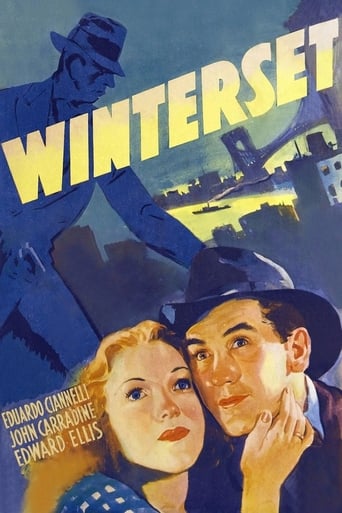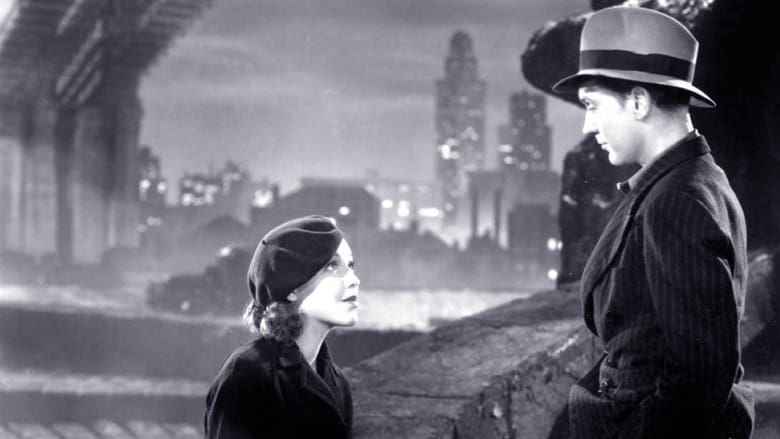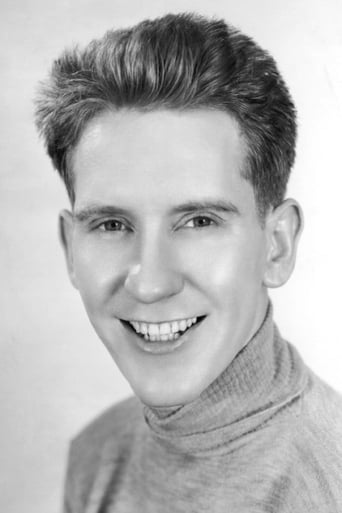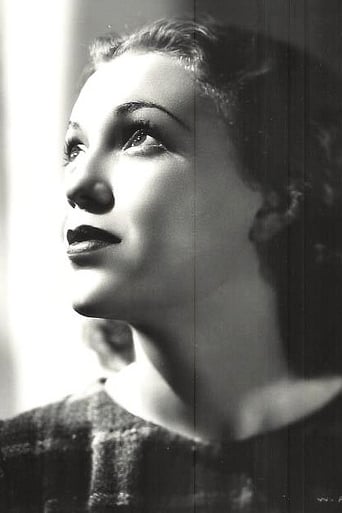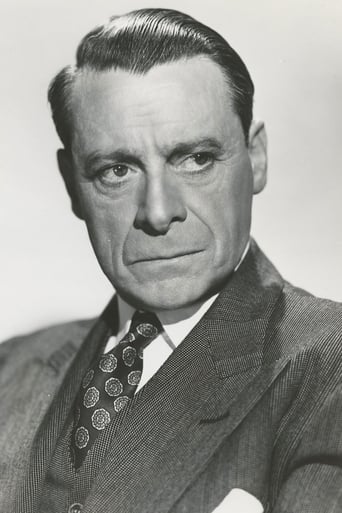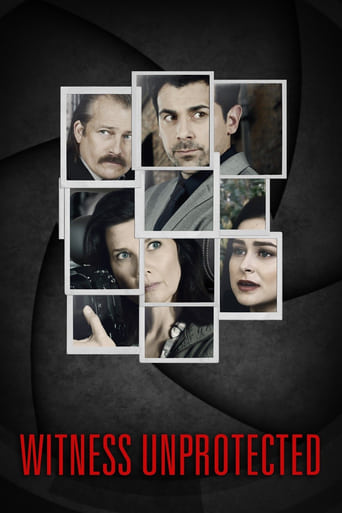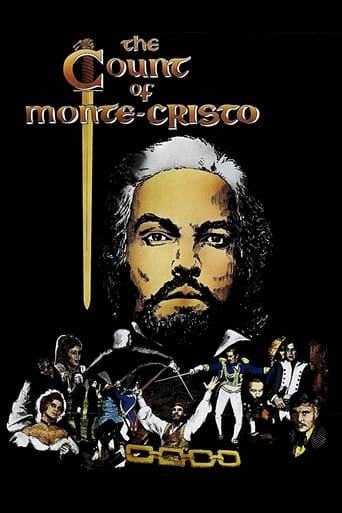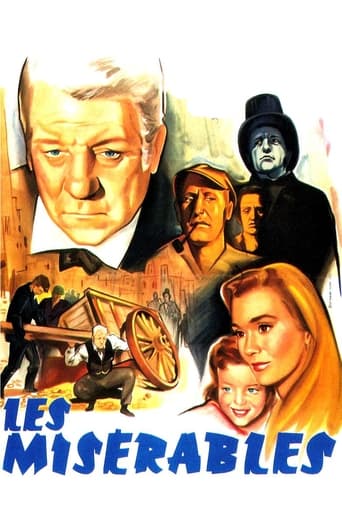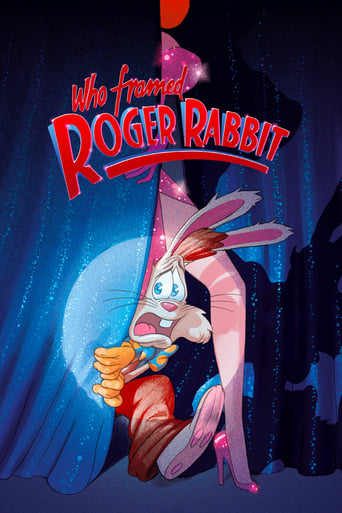Winterset (1936)
A man is determined to find the real culprit behind the crime for which his father was wrongly executed.
Watch Trailer
Cast
Similar titles

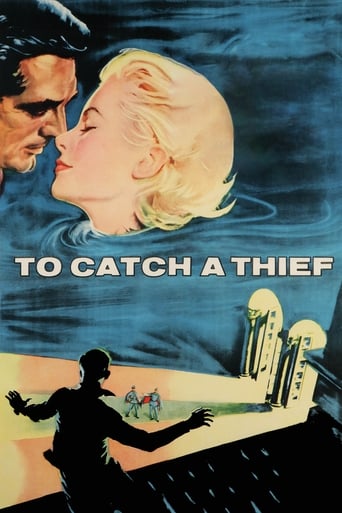
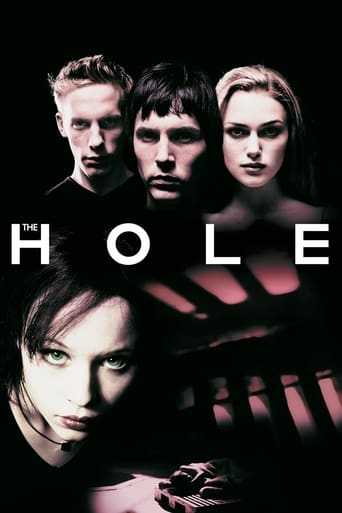

Reviews
Such a frustrating disappointment
Simply Perfect
I wanted to but couldn't!
It's the kind of movie you'll want to see a second time with someone who hasn't seen it yet, to remember what it was like to watch it for the first time.
What we have to ask ourselves is what are the chances that a judge who sent an innocent man to the chair some sixteen years previously and has taken to wandering Lear-like the streets of the city in inclement weather, will fetch up in the hovel-like home of the one witness who, had he been called to the stand could have proved the innocence of the condemned man, at the same time as the son of the condemned man, now a drifter, who has arrived, purely by chance from the other side of the country or 3,000 miles whichever is the greater, and, for good measure, the actual real killer. This is beyond contrivance and is not helped by the poetic dialogue playwright Maxwell Anderson puts into the mouths of his characters, particularly that of the son. Anderson clearly based his play - adapted by himself for the screen - on the execution in 1927 of Sacco and Vanzetti widely believed to be innocent of and crime. In an effort to distance his story from the real case Anderson moved the time back to 1930 and dispensed with one of the two falsely accused but while the case was still generating ink in the US decades later it had little impact in the UK. Anderson meant well and had a penchant for lofty themes but seen in 2015 it seems both stilted and dated.
Uggh! This was an absolutely terrible film and I can easily understand why it was allowed to sink into the public domain. The problem is not so much the leftist slant of the film, but that ALL of the dialog comes off as incredibly stagy and fake. Not one minute did I feel that the characters were real or that this was supposed to be real life--and it felt like an overly 'deep' play that was brought to the screen without any concern for how watchable the final product would be."Winterset" is a story that is a thinly veiled retelling of the Sacco-Vanzetti trial of the early 20th century. While there was an apparent rush to judgment to convict and execute the two anarchists of murder, there is evidence today that would suggest that at least Sacco was guilty. Decades after the executions of the pair, Hollywood leftists took the case under their wings--and even today it's a famous case for its miscarriage of justice. This film is an after the fact retelling of the case. While the case is interesting in many ways, however, the film is absolutely dreadful because it is so earnest and self-important. In other words, the story seems so superior and unreal in the way it was told--and the characters all come off as one-dimensional and fake. While leftists (like the leading man, Burgess Meredith) must have been filled with a sense of self-importance while making the film, they never seemed to bother to look at the story to see if it seemed real in any way. Had they done this, they would have clearly re-written the film and made the characters more realistic and the dialog at least halfway convincing. Instead, it just seemed like a very long and drawn out preachy polemic--the sort of film the public would ignore and the film makers adore. The bottom line is that this divisive and confusing case deserves a better treatment than this film--which looks more like a propaganda film than anything else. Fake, fake and fake from start to finish, as NO ONE talks the way these characters did.
Despite having read the liner notes, I thought from the publicity artwork that WINTERSET would be something Gothic. It is Gothic, in its bleakness, but is squarely centered in the Depression era of the United States. It was completely of it's time, and considering that the film was adapted from the Broadway play, it must have been daring, with sub themes of socialism and police corruption. (The play was by Maxwell Anderson, who wrote KEY LARGO and THE BAD SEED.) Perhaps that contributed to the film receiving two Academy Award nominations.This is the story of Mio (Bartholomio a young, dewy Burgess Merideth) trying to clear his father's name. In the first scenes, his namesake Father, played with riveting stillness by the painfully thin John Carradine, was accused of murder he did not commit, given no defense, and put to death. Years later, his son goes to the slums of New York to try to find out the truth.I had to remind myself that this was made in 1936, so it is still very early in the talkies. The sets are a wonderful blend of realism and expressionism (similar to the famous stage sets of Arthur Miller's A VIEW FROM THE BRIDGE), giving this a Gothic noir flavor. Rain is often used as a "purifier" in stage and film, but here it is effectively used to create an oppressive humidity, a torrent of sludge. It is clear that film noir, Orson Wells, and THE THIRD MAN's Director Carol Reed all owe a debt to early films like this. The set elements are all here in tight proximity, the stone, the shadowed doorways, the waterways.In fact, one irony is that one of the lead actors does look very much like Orson Wells. He plays the brother of Mariama (played by Margot, who is probably best known as the duplicitous woman in Capra's LOST HORIZON). Margot's transition to film is not as ideal as Merideth's, her style is more of the old school careful vocal production that may be the product of overcoming an accent. But she looks luminous and innocent, and fills the screen with a simple hopefulness at odds with the dark surroundings. The villain of the piece is simply fantastic completely believably sociopathic without any extravagant ticks or frothing at the mouth.This is pre-method-acting, but that spare realism is all here, especially in the performances of Carradine and Merideth. This entire film holds up as a moment of history of social themes and thought of that day that still resonate. The Broadway cast seems to have been lifted intact (which should be a lesson to modern filmmakers to use stage actors instead of vice-verse). There are one or two flowery monologues, but for the most part, the transition from stage to film goes very well, and the story and script are spare and universal enough to stand the test of time well. This is a fascinating moment of film history which has luckily made its way to DVD.
From RKO studios in 1936 (though it looks as though it were made in the earliest 30s), during the heyday of the Astaire-Rogers musicals, came something rich and strange. Maxwell Anderson's very serious poetic play was boiled down into a movie that's part Depression-era gangster flick, part Shavian social-issue drama, and part neo-Greek tragedy.The igniting fuse was the Nicola Sacco/Bartolomeo Vanzetti case of 1927, where two immigrant anarchists were condemned (some would say railroaded) to death supposedly for a robbery in which guards were killed. Anderson pushes it back to 1920 and focuses on a single man, Bartolomeo Romagna (John Carradine), whose auto, filled with anarchist/socialist tracts, is stolen for a similar crime by gangster Eduardo Cianelli. When condemned, Carradine eloquently rebukes the judge (Edward Ellis).The film now flashes forward to 1936, when Romagna's down-and-out drifter son (Burgess Merdith), spurred by revisionist theories of the case, journeys to New York to confront the surviving principals, including Cianelli, Ellis and a reluctant witness (Paul Guildfoyle). All converge for a reckoning preordained by The Fates....Anderson has heightened his dialogue to lend it immortal aspirations (which may have been a grandiose miscalculation the dominant rhetorical mode of the twentieth century, obvious even by 1936, is flatting). The high-flown posture extends to the look of the film, too a stylized nightscape that's a harbinger of the look of film noir to come a few years later. A low-ceilinged tenement-basement flat is oppressively claustrophobic (markedly so, given the number of actors crammed into it), while the cobblestones and stone arches of the low-rent streets near New York's waterfront glisten wickedly in the pelting rain. (At times the slums look like the central squares of those Transylvanian villages so common in Universal horror pix of this era).Almost every element of Winterset should seem laughable now but doesn't (though there are a few close shaves). There's an early sequence involving a hurdy-gurdy that lures the slum-dwelling underclass out of its burrows to dance that's hauntingly powerful as is the face of Winterset's love interest, an actress known as Margo, that harks back to the expressiveness of the silents.
